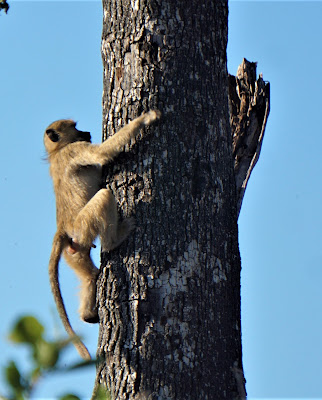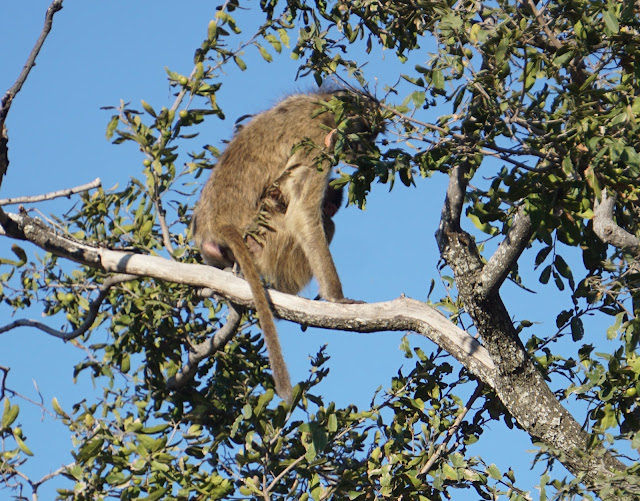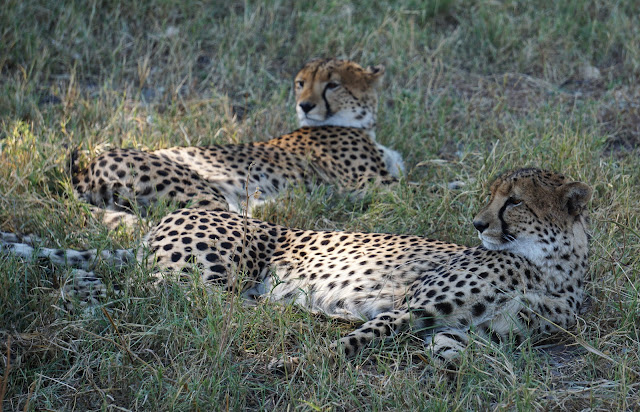KT was ever vigilant in looking for signs of wildlife:
Next we saw what seemed to be a pretty nonchalant herd of zebras, but then we noticed that there was almost always one keeping his eye on us while the others grazed:
I shouldn't complain about my age spots, right?
Next up, Pumbaa, which is what KT called every warthog that we saw:
Those are gnarly tusks:
Then a few skittish impala . . .
. . . and right around the corner was the Baboon Treehouse:
The baboons were busy eating breakfast, which looked a lot like marula, the same fruit Franklin the Elephant in our camp liked to eat:
Baboons are proficient climbers:
Even the babies can scamper up the tree trunk with amazing speed:
They also have a great sense of balance:
What they don't have is a handsome face:
KT never felt the need to detour around the water. We just plowed right through it, and sometimes the vehicle had only a few inches before we would have been water-logged.
The tsessebe is much larger than the female lechwes in the harem, and he seemed to get along just fine with the male lechwe sheikh.
A tsessebe is distinguished by its almost bluish skin, a bit like the skin of a wildebeest, and by the giraffe-like hump on its upper back:
We came across a swiftly flowing stream with some large boulders in the middle, a place KT had decided would be a great spot for breakfast. He had brought along some hot chocolate, egg salad sandwiches, and muffins for us.
He pointed out a trampled track that led from the water to the bush and warned us that if we ever saw a hippo coming down one of those tracks, we'd better run (no, that wouldn't work) PRAY. Hippos on the move are very deadly animals. Notice that no one is ever riding one in movies like Swiss Family Robinson.
We weren't the only ones enjoying some breakfast by the water. It was one of the rare times we saw other vehicles full of people while we were out driving:
There were about eight hippos in the water, and occasionally they snorted or grunted noisily to each other in pig-like conversation.
They came closer and closer to our vehicle:

Look at that baby!
He/she was just barely visible in the tall grass:
Judging by their two-toned skin, some of them had been swimming in the stream:
After we were a safe distance away, KT told us a story about an angry elephant that had stuck her tusks into the front of a vehicle filled with six tourists, a driver, and a spotter, and had lifted it off the ground, swinging it back and forth. KT and another driver drove up quickly from different directions to serve as a diversion. They managed to scare off the angry elephant, and then all three vehicles drove quickly away. The frightened and very upset tourists demanded a full refund from the camp and an immediate flight out. "Very unfortunate," KT said.
Just as KT had found the leopards the day prior, he found the wild dog pack by driving off road and following some obscure directions given to him by the other guide. We arrived to find EIGHT sleeping dogs, tired from the morning hunt and sprawled out on the grass among some bushes:
. . . but clearly we were disturbing their morning nap:
They almost look like the neighbor's German shepherd:
. . . until you see the bizarre mixture of colors and patterns on their fur. No dog I've ever seen has a coat as crazy as this, not even the speckled hyenas:
No two have the same markings:
Bob, who took this final picture, was over the moon with this once-in-a-lifetime photo op:
Towards the end, KT jokingly said, "Bob, why don't you get out and stand with them so that Judy can take a picture?" Not catching the intended humor, Bob started to climb out of the vehicle, at which point KT said in a rather panicked voice, "No! No, Bob! I was kidding! Don't get out!" As with other wild African animals, though these look like pets, they are far from being tame. In fact, they are known for ripping their prey apart while it is still alive rather than strangling it first as lions do.Yeah, stay in the 4-Runner, Bob.
Time to move along:
We had detoured at the beginning of the drive to the area where KT heard cheetahs had been spotted, and we had looked carefully, but we had not seen anything. We went through the same area again after seeing the wild dogs, and when KT spotted a cheetah looking alertly at us from behind a tree, he began to laugh. "Cheetahs!" he chuckled. "Now you are gong to have to give me more money!" He thought it was pretty hilarious. (And Bob did indeed add some more money to his tip.)
We were pretty excited, as you can imagine. A week earlier, we had been able to pet a couple of these magnificent felines at Cheetah Outreach near Cape Town, but I think seeing them in the wild was an even bigger charge than touching them in an enclosure had been.
The cubs:
The mama:
Once she saw that we weren't going to bother her babies, she relaxed:
Cheetah cubs have what looks like a mohawk running down the back of their heads and between their shoulders:
Then she would plop back down onto the grass with her cubs. It's impossible to tell who is who in this picture:
"I know, dear. Just close your eyes like this and go to sleep."
"I'm trying! I'm trying!"
"Hey! He kicked me!"
KT told us that cheetahs are the only cats that don't scavenge--they only eat what they kill themselves. Also, they are at the bottom of the food chain. Every other carnivore eats them. That's why they have to run so fast. They can reach speeds of up to 75 mph in short bursts, making them the fastest land animal in existence.
We had been gone from camp since just before sunrise, and it was time to return for lunch and a nap before our next outing. We said good-bye to the cheetahs and headed back to camp. KT pointed out what is locally known as a "sausage tree" (for obvious reasons):
The official name is the Kigelia tree. These seed pods are eaten by elephants, giraffes, baboons, hippos, and a few other animals, but we were not about to try one.
Water, water everywhere!
Hey! A bridge! Well, KT didn't think we needed it:
A waterbuck is hiding in the bushes . . .
He looks a lot like this reedbuck who is hiding the tall grasses:
Their horns remind of me Maleficent in Sleeping Beauty:
Thanks, KT! It was a day to remember!
Next up: Animal sightings IN camp.
READING
 I loved Whatever You Do, Don't Run: True Tales of a Botswana Safari Guide by Peter Allison, an Aussie working as a safari guide in the Okavango Delta and trying to compete with all the local Botswanian guides. The author recounts a series of hilarious vignettes covering everything from cranky tourists to flooding his automobile in a croc-infested river.
I loved Whatever You Do, Don't Run: True Tales of a Botswana Safari Guide by Peter Allison, an Aussie working as a safari guide in the Okavango Delta and trying to compete with all the local Botswanian guides. The author recounts a series of hilarious vignettes covering everything from cranky tourists to flooding his automobile in a croc-infested river.Both my husband and I read this book, and we found that we could identify with many of the experiences the author relates. This is a GREAT book if you are planning a trip to the Okavango Delta.




































































































What a great morning - leopards, wild dogs, cheetahs, elephants, zebras, tsessebe, red lechwe, waterbuck, reedbuck. Really one of the highlights of my life. You might recall that on our way back KT said we were going to find a lion. I said to him, you just want a bigger tip. He laughed and laughed. But I would have given him one...
ReplyDelete